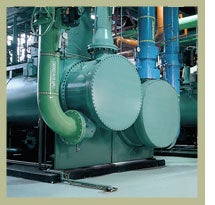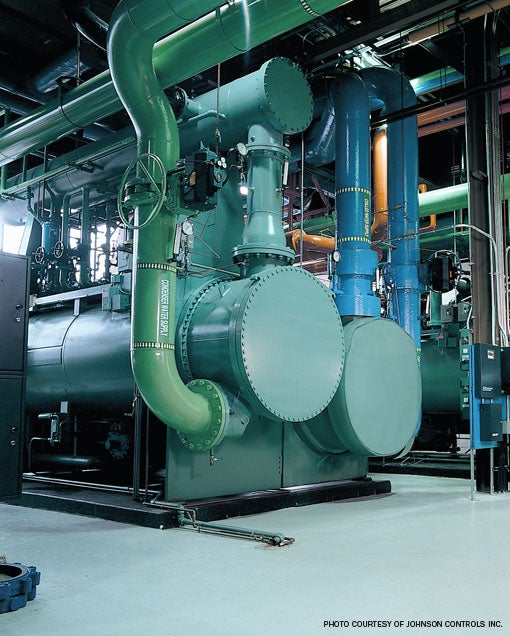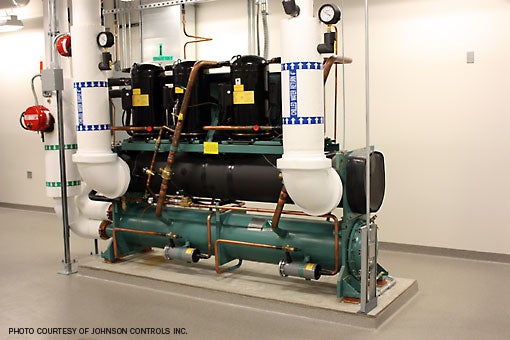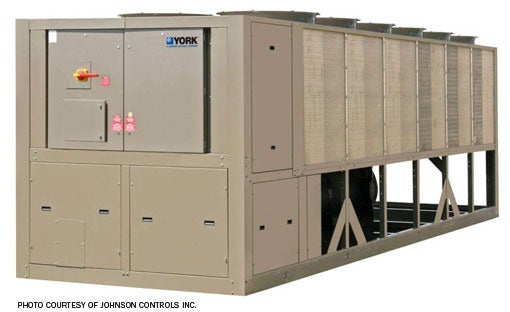Cool advice
 Chillers often represent the largest single energy consumer in a facility, so the efficient operation of a chiller can significantly impact a company's bottom line. Efficiency is often determined by the design of the chiller, its controls and how well the unit's capacity matches building load. However, other factors also contribute, beginning with proper start-up procedures. When combined with a regular maintenance program, these procedures can effectively reduce the costs associated with operating and repairing a chiller.
Chillers often represent the largest single energy consumer in a facility, so the efficient operation of a chiller can significantly impact a company's bottom line. Efficiency is often determined by the design of the chiller, its controls and how well the unit's capacity matches building load. However, other factors also contribute, beginning with proper start-up procedures. When combined with a regular maintenance program, these procedures can effectively reduce the costs associated with operating and repairing a chiller.
Proper seasonal start-up ensures that a chiller operates efficiently and reliably. At the same time, it provides an opportunity to inspect the unit and make recommendations that will reduce energy costs and improve plant operation. For example, a qualified technician might recommend dropping the chiller's entering condenser water temperature to the minimum allowed by a given manufacturer. This simple step will improve chiller efficiency and in some cases may increase the unit's cooling capacity.
Where plants include multiple chillers, a technician might recommend changing the sequencing of the units so that they operate in a more efficient and reliable manner. In the case of an oversized chiller, recommendations can also be made to modify a unit and/or its control settings to help optimize its operation at light load conditions.
Reviewing shut down
When starting a chiller, the assumption is that the unit was shut down properly and in a controlled manner. This helps to ensure the safety of those working around the equipment while protecting the chiller from damage during the period it is not operating. The shut-down process begins with a review of the control panel functions for proper operation and evaluation of recorded fault histories. The goal is to be certain the chiller is functioning well prior to shut down and identify deficiencies that can be addressed during the shut-down period. This ensures that the machine will be ready to start as soon as it is required.
This is also the time to verify proper operation of the oil or crankcase heater(s). These heaters must be energized for a given time period prior to start-up to make sure that the refrigerant is separated from the oil. They are designed to boil off the refrigerant that has been absorbed by the oil during the off cycle.
Water bundles should be isolated and drained as part of the shut-down procedure. Once draining is complete, the water side of the bundles should be checked (using a refrigerant leak detector) to make certain that no leaks are present in the tubes.
 |
| The marine water-box cover plates in this large-tonnage installation are to be removed for tube cleaning. |
At the same time, a thorough leak check of the chiller should be conducted. All identified leaks should be repaired immediately to prevent refrigerant loss during shut down. For those chillers that are subjected to sub-freezing temperatures, winterization of the heat exchanger bundle(s) may be required to prevent freeze damage.
Finally, the shut-down procedure should include cleaning the heat exchangers and condenser coils. Water boxes should be removed and the tubes brush cleaned. After cleaning, bundles need to be dried to prevent corrosion during the storage period and the water boxes reinstalled. If completely drying the bundle is not an option, corrosion inhibitors are available that are specifically designed to provide adequate corrosion protection. Condenser coils (where applicable) should be washed in a manner that will not cause fin damage (refer to specific manufacturer instructions for details). Then, tag the chiller as out-of-service and take an inventory of emergency spare parts, replenishing them as necessary.
Starting it up
Start-up of a chiller normally takes place at light load conditions and begins with the removal of the shut-down tag from the chiller. At this point it is important to verify that the chilled and condenser water valves are in their proper operating positions. Then, the cooling tower and heat exchangers can be filled.
Care should be taken to check for proper condenser and chilled water flows. In addition, the technician should check the oil sump and/or compressor oil levels using the factory-installed sight glasses.
Where applicable, be certain the oil return system is operating properly. Large tonnage water-cooled chillers use oil return systems to effectively return oil to the compressor so that a proper oil supply is present. If these systems fail to function properly, the chiller will shut down on one of its safety switches to prevent damage to the compressor.
On a related note, oil filters should be replaced per the manufacturer's recommendations to assure that particulate-free oil is being supplied at all times to the compressor. This, in turn, helps to ensure adequate lubrication of compressor bearings. It is also important to review the control panel for proper operation and check system pressures and temperatures to be certain the chiller is running in an optimal fashion.
 |
| The filter driers at the bottom of this water-cooled, scroll chiller should be changed and the condenser bundle cleaned per manufacturer recommendations. |
Start-up may also be an ideal time to conduct a vibration analysis. This analysis should be performed at least annually to ensure that both the compressor and motor are in good working condition. This procedure can identify an issue before a catastrophic failure occurs, reducing down time and repair costs if the problem is identified early.
The best time to conduct a vibration analysis is at full-load conditions. If adequate load is not available at start-up, it is important to return and perform this test when the chiller is operating at full load. In any case, the results of the analysis can be compared with earlier baseline results. If baseline readings were never gathered, it is never too late to start this valuable procedure. It is also important to note that trending these and other test results helps identify changes over time that may indicate problems that require corrective actions.
Finally, record and log all operating parameters to make sure that the chiller is functioning properly at a given load and to help diagnose problems. Parameters can be trended and used to evaluate the performance of a given component over time. When problems are detected and subsequently corrected, chiller performance should approach the original baseline readings for a given load condition, assuming that no internal degradation and wear of components has occurred.
Analyzing the data
An analysis of operating data should focus on two main performance indicators: capacity (tons) and efficiency (kW/Ton or the amount of energy that is being consumed to generate one ton of refrigeration).
In the ideal scenario, a chiller satisfies the cooling demand (tons) as efficiently as possible (low kW/ton). A qualified technician can evaluate how a unit is operating, compared to its design tonnage and kW/ton, and make recommendations that will return the chiller to new or close-to-new conditions. This evaluation typically identifies the following:
- Insufficient refrigerant charge, which leads to poor heat transfer performance in the evaporator and unreliable operation;
- Too much refrigerant, which can lead to refrigerant carryover into the compressor, inefficient operation and possible damage to the compressor impeller and bearings;
- Poor heat transfer, due to tube (internal) and refrigerant side fouling in the evaporator and/or condenser bundles, which can lead to inefficient and possibly unreliable operation.
In situations where a chiller runs year-round and does not go through the shut-down/start-up process, facility managers should follow the recommended maintenance procedures identified by the equipment manufacturer. Doing so minimizes the risk of a catastrophic failure, extends the life of the equipment, ensures its efficient operation and reduces the cost of future repairs. It is important to note that different chiller types have different manufacturer recommendations, with some tasks being performed three or more times a year and others annually.
In every case, maintenance procedures, as well as shut-down and start-up procedures, should be performed by a qualified technician wearing protective equipment. After all, heating, ventilation and air-conditioning (HVAC) equipment is inherently dangerous and brings with it the potential for personal injury due to moving parts, the potential for electrical shock, and exposure to high refrigerant pressures associated with the equipment.
 |
| The condenser coils are clearly visible in this small-tonnage, air-cooled chiller. |
Choosing a technician
In selecting a technician, be certain to choose someone who is experienced servicing the type of chiller in your facility. Most original equipment manufacturers employ highly trained professionals that have the skills and tools to perform the work.
A qualified technician from a large service network also offers access to an even larger array of resources, including technical literature, service bulletins and, in some cases, a technical support and engineering group that fully understands how to get the most from a particular piece of equipment. These resources will ensure that appropriate recommendations are provided as quickly as possible.
Using the services of a qualified technician to perform start-up procedures delivers several important benefits:
- Improved chiller performance and reliability;
- Minimized downtime;
- Potential energy savings of 30 percent or more;
- Maximum equipment life;
- Minimal repair and service costs;
- Greater return on capital equipment investment.
The bottom line – proper start-up procedures can yield dividends well into the future.
Rick Nadeau, P.E., is the director of mechanical services for the Johnson Controls Service Organization, Milwaukee, Wis. He can be contacted at Rick.Nadeau@jci.com.




